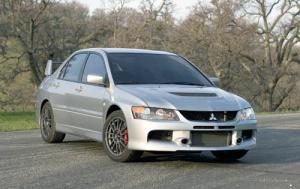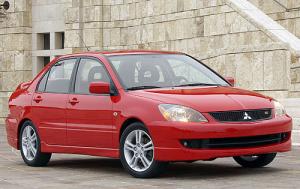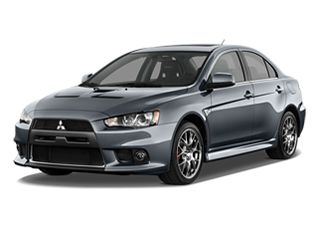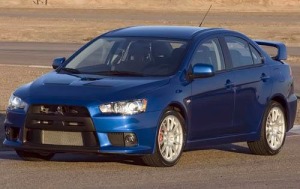
The last generations of the Mitsubishi Lancer were produced for the 2002 through 2017 model years. And wow, talk about a car with a few choices! The extremely versatile Lancer can be found as anything from a fairly standard family sedan to a turbocharged, pimped up, zooming headturner.
And with extremely high used car prices today, is an older Mitsubishi Lancer worth considering as a way to save significant dollars in the current market?
True, it had a lot going for it back in the day. But today, people who are looking for "older" vehicles that better fit their budgets need to know how it has actually performed in the real world over its history.
In other words, essentially, has it aged well?
And by "older", I'm generally referring to 10+ year-old Lancers, so those produced in its seventh (2002 - 2007) and eighth (2008 - 2017) generations. Going back further may raise the reliability factor a bit too much.
So here, ...
- We'll take a look at the established reliability of these older Lancer models all these years later.
- Then we'll list areas of owner-reported mechanical problems that should be checked before buying one today.
- And then we'll do an overview of the vehicle's various features and options that can be found on these models.
But first, two important suggestions ...
1. Know How To Get The Lowest Used Car Price:
Get Dealers To Compete For your Business: When you are searching vehicles to possibly purchase, the following is the absolute best way to get the lowest price, and it is extremely easy and stress-free.
Just go to a national car listing site, (I happen to prefer CarsDirect.com for their massive dealer participation and ease of use, although others will get the job done as well) and find several listed vehicles that you may be interested in.
Then write something like the following in the "Check Availability" box or "Contact Dealer" box or whatever the site you are using uses.
"Hello, I've contacted several dealers about cars I am interested in and am looking for the best value. I am also a serious buyer planning to make a decision soon. Please send me your best out-the-door price. Thank you.
After receiving the offers, follow up by explaining that based on the price, you're leaning in another direction but still really like their car and would certainly consider another offer. When dealers drop out, you'll know you're at the best price.
Using the internet to get dealers to compete for your business is extremely important. More details on this and how to intereact with the dealers can be found here at Best Used Car Buying Techniques.
2. Things To Do When Considering An "Older" Lancer:
Locate Lower Mileage Vehicles: They are certainly out there to be found with careful and patient shopping. Be willing to drive a distance if you have to.
Vehicle History and Maintenance: Ask for the vehicle history report (CarFax or AutoCheck) as well as documented maintenance and repair records. If not provided by the dealer or private seller, it's best to move on.
Pre-Purchase Inspection: Have the vehicle independently inspected before making a final decision. This usually will cost in the $150-$200 range but is well worth it given the potentially thousands in savings over the long term.
2002 - 2017 Mitsubishi Lancer Reliability
With regular maintenance, the seventh and eighth generation Lancers are generally considered to be reasonably reliable. Key points include:
Engine Longevity: The standard Lancer models with regular maintenance (such as oil changes, timing belt/chain replacements, and fluid checks) have been known to last well over 200,000 miles. Timing belt-related issues were a concern in the 7th-gen, while timing chain issues were more of a concern in the 8th.
Transmission: Regular CVT fluid changes are crucial. If maintained properly, the CVT can be reliable, but neglect can lead to costly repairs. The seventh generation had more reports of issues with both automatic and manual transmissions, though not as prevalent with CVTs since these were more common in the eighth generation.
Standard Models: These have a mixed to above-average reliability rating. Common issues (mainly with the CVT) can be mitigated with proper maintenance.
Lancer Evolution X: While highly praised for performance, it is known to be more maintenance-intensive. The performance parts are more prone to wear and tear, and the vehicle generally requires more frequent and detailed maintenance.
Many older Mitsubishi Lancer models are still on the road, in itself an indication of its reliability. In addition, the availability of replacement parts and a community of enthusiasts help in maintaining older models.
While the seventh generation Lancer shared some common issues with the eighth generation, there were notable differences, particularly regarding transmission and engine maintenance. Both generations required diligent maintenance to ensure reliability, with the seventh generation facing more frequent rust issues and timing belt maintenance.
Despite these challenges, both generations of the Lancer have been appreciated for their durability and continued presence on the road with proper care.
2008 - 2017 Mitsubishi Lancer Mechanical Problems
Although far from univeral, all of these issues should be included in a comprehensive vehicle inspection before buying:
Standard Lancer Models:
CVT Transmission Issues: Some owners experienced shuddering and hesitation during acceleration, which could lead to a less smooth driving experience. The CVT could also overheat, especially under heavy load or in hot climates, potentially leading to failure if not addressed.
Oil Consumption: Excessive oil consumption was reported in some engines, necessitating more frequent oil checks and top-offs.
Timing Chain Issues: Some models had problems with the timing chain tensioner, which could lead to chain noise or, in severe cases, engine damage if not addressed.
Strut and Shock Wear: Premature wear on struts and shocks, leading to a rough ride and poor handling.
Control Arm Bushings: Wear on control arm bushings could cause clunking noises and poor handling characteristics.
Sensor Failures: Various sensors, including oxygen sensors and mass air flow sensors, were prone to failure, leading to check engine lights and potential drivability issues.
Battery and Alternator Problems: Some owners reported issues with the battery and alternator, leading to starting problems or electrical system failures.
Lancer Evolution X:
Clutch Wear: The clutch in manual transmission models could wear out prematurely, especially in aggressively driven vehicles.
Synchro Issues: Transmission synchro problems, particularly in higher gears, could cause difficulty shifting.
Turbo Failure: Turbocharger issues, including boost leaks and complete turbo failure, were reported, especially in modified or heavily driven vehicles.
Oil Leaks: Leaks from the turbo oil feed line and other engine seals were not uncommon.
Overheating: The Evolution X could experience overheating, particularly when driven hard or on the track, requiring upgrades to the cooling system for better reliability.
Bushing Wear: Suspension bushings, particularly in performance models, were prone to wear, affecting handling and ride quality.
Steering Rack Issues: Some owners reported problems with the steering rack, including noise and a lack of responsiveness.
2002 - 2007 Mitsubishi Lancer Mechanical Problems

Again, although far from univeral, all of these issues should be included in a comprehensive vehicle inspection before buying:
Automatic Transmission Problems: Rough or jerky shifting was reported by some owners. In some cases, the automatic transmission failed prematurely, often requiring a costly rebuild or replacement.
Manual Transmission Problems: The clutch was prone to wear, especially in vehicles that were driven aggressively. This led to the need for clutch replacements more frequently than expected. There were also some reports of problems with transmission synchros, causing difficulty in shifting smoothly between gears.
Oil Consumption: Some engines were prone to excessive oil consumption, requiring more frequent oil checks and top-offs.
Timing Belt Issues: The seventh generation Lancer used timing belts that required regular replacement. Failure to replace the timing belt at recommended intervals could lead to severe engine damage.
Strut and Shock Wear: Premature wear on struts and shocks was a more common complaint, leading to a rougher ride and decreased handling performance.
Control Arm Bushings: Wear on control arm bushings could cause clunking noises and poor handling.
You May Also Like:
The Easiest Car Negotiation Technique
All About Wholesale And Trade-In Car Prices
Sensor Failures: Various sensors, including oxygen sensors and crankshaft position sensors, were prone to failure, leading to check engine lights and drivability issues.
Alternator and Battery Problems: Issues with the alternator and battery were reported, causing electrical system failures and starting problems.
Radiator Leaks: Some owners reported leaks in the radiator, which could lead to overheating if not addressed.
Water Pump Failures: Water pump failures were not uncommon, which could also contribute to overheating issues.
Fuel Pump Failures: Some owners experienced fuel pump failures, leading to issues with starting and engine performance.
Older Mitsubishi Lancer Overview

Most carmakers leave the upgrades to individual car buyers in the performance aftermarket. Much less so for Mitsubishi back then. They took it on themselves so their customers could simply turn the key and head off to enjoy.
The much acclaimed Lancer Evolution (or EVO) offers the type of performance usually found in European sports cars with much higher price tags. All three pre-2008 trims, the IX, RS and MR, were powered by a dynamic 286-horsepower turbocharged 2.0-liter four-cylinder engine. The IX and RS came with a 5-speed manual transmission. The MR with a 6-speed.
There was no automatic transmission option with this car. With its precision handling and turbo acceleration, it just wouldn't be right. Remember, this vehicle was originally designed for the World Rally Championship (WRC).
Edmunds.com pretty much summed it up: "Through road and comparison tests, our editors found the Evolution to exhibit nearly perfect driving dynamics. With virtually no turbo lag, acceleration is seriously quick with a mid-5-second 0-60 time. Steering is pinpoint precise and predictable."
Toning things down a bit were the ES, SE and O-Z Rally Lancer trims. From 2002 - 2007 each was powered by a 120-horsepower 2.0-liter four-cylinder engine. There's also a sport-tuned Ralliart model with a 2.4-liter four-cylinder that's good for 162 horsepower. While a 5-speed manual transmission was standard for all models, there was a 4-speed automatic available as an option.
The ES came fairly well-equipped with standard features such as air-conditioning, full power accessories and a CD player, while the O-Z Rally model added a sportier appearance with features such as 15-inch O-Z alloy wheels and unique interior trim upgrades. The LS trim went on to add features such as remote keyless entry, cruise control, and antilock brakes (ABS).

For 2004, the Lancer Ralliart made its debut featuring increased power, a sport-tuned suspension, alloy wheels and ABS. 2004 also saw the introduction of the short-lived Lancer Sportback wagon, offered in LS or Ralliart trims and powered by the 162-hp four-cylinder (but only available with the 4-speed automatic transmission).
For 2005, Mitsubishi discontinued both the Sportback and Lancer LS models. However, the 2006 model year saw the introduction of the Lancer SE which featured a sunroof, remote keyless entry, a 6-speaker stereo system and cruise control.
The Lancer was redesigned for 2008 and carried through to 2017. Initially, it was produced in DE, ES and GTS trims, all of which were powered by a 152-horsepower four-cylinder engine. The GTS was also outfitted with a sport-tuned suspension.
For 2009, a 2.4-liter four-cylinder debuted along with the return of the Ralliart model. In 2010, power door locks, stability control and 4-wheel antilock brakes became standard on all models (stability control was previously only available on the Ralliart).
There were also some minor interior and exterior style revisions in 2010, while 2012 saw the addition of the SE model to the lineup (came with a more powerful engine, a continuously variable transmission, all-wheel drive and the Alloy Wheel package).
For 2013, the GT model was added. It was based on the all-wheel-drive SE model, but without the all-wheel control system and featured a sportier suspension, more upmarket options, and an optional manual transmission.
Typical standard features on the base DE included power mirrors, power windows, a tire-pressure monitor, 16-inch steel wheels, halogen headlights, a tilt steering wheel, dual-reclining bucket seats, a trip computer, an anti-theft system, and a 4-speaker CD/MP3 audio system. Some can also be found with the optional A/C and Power Package that added ABS, air-conditioning, and power door locks.
The Lancer ES added the A/C and Power Package as well as 16-inch alloy wheels, cruise control, keyless entry, steering-wheel audio controls, upgraded upholstery, manual driver seat height adjustment, and a 60/40-split rear seat with a center armrest.
The top-of-the-line GTS then went on to add a sport-tuned suspension, 18-inch alloy wheels, a body kit with a rear spoiler; sport bucket front seats, automatic climate control, a leather steering wheel and shift knob, and a 6-speaker CD/MP3 stereo with Bluetooth connectivity.
The Lancer Evolution (EVO) was also redesigned in 2008 and was powered by a 2.0-liter turbocharged four-cylinder engine that's good for 291 horsepower and 300 pound-feet of torque. The EVO X model was also introduced in 2008.
Production of the Evolution was skipped for the 2009 model year and restarted for 2010, and then ended for good with the 2015 model.

Two Evolution models were offered: GSR and MR. The GSR was aimed at serious driving enthusiasts with its sportier suspension settings and smooth 5-speed manual transmission, while the more costly MR came with a somewhat softer (but still aggressive) suspension and was paired with a twin-clutch manual transmission with a traditional automatic mode. And this transmission was a good one, considered one of the quickest available in full-throttle upshifts.
Standard equipment included 18-inch alloy wheels, cruise control, foglights, full power accessories, keyless entry, a leather-wrapped tilt steering wheel, Recaro sport bucket seats and a six-speaker stereo with single-CD player. The MR is similar but added ABS, alloy wheels, softer springs and shock absorbers, a larger rear wing, steering-wheel audio controls, Bluetooth, and HID xenon headlights.
For the 2010 model year, the Evo introduced a more upscale MR Touring model which included a leather interior, a sunroof, heated front seats, rain-sensing wipers, and additional noise insulation.
Also, Always Know The Value Of Your Trade-In
Whether you are trading or selling on your own, it's just a good idea ... even whether you are in the market or not at the moment. You can then use this important information for a number of purposes ... to negotiate with a dealer, or to know how to price your car in the retail market, or simply to know the value of one of your assets, which is always a good idea.
Getting trade-in values online tend to vary a lot from site to site. But I've found the one at Edmunds Trade-In Quotes is particularly comprehensive and accurate.
It's free and just takes a couple of minutes. I think what helps its accuracy is the inputs will include either your plate# or VIN# followed by many simple, but specific, yes/no questions. It really focuses in on the detail of the specific vehicle.
 By Josh Rosenberg
By Josh Rosenberg